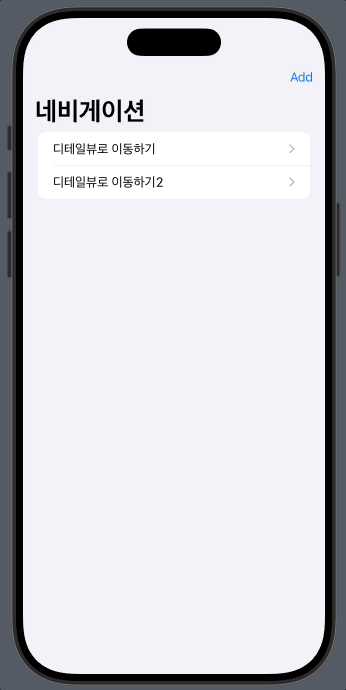-
웹개발자의 iOS 개발기(7) - [SwiftUI] 모달, 네비게이션, 탭뷰iOS 2025. 1. 26. 01:09
모달, 네비게이션, 탭뷰에 대하여 공부해 보았습니다.
01. 여러 화면을 이동하기
Modal
import SwiftUI struct _1_Modal: View { @State var showModal: Bool = false var body: some View { VStack { Text("메인 페이지 입니다.1") Button { showModal = true } label: { Text("Modal 화면 전환") } } .sheet(isPresented: $showModal) { _1_Detail(isPresented: $showModal) } } } #Preview { _1_Modal() }Detail
import SwiftUI struct _1_Detail: View { @Binding var isPresented: Bool var body: some View { Text("모달 페이지 입니다.2") Button { isPresented = false } label: { Text("닫기") } } } #Preview { _1_Detail(isPresented: .constant(true)) }@Binding
- 부모뷰에서 자식뷰에 데이터를 전달할 때 사용
- 부모뷰가 상태값을 소유하고, 자식뷰가 이를 수정해야 할 경우 사용
@Binding 주의점
- 상태 소유는 부모에서만: 자식 뷰는 상태를 소유하지 않습니다. @Binding은 항상 부모에서 소유한 상태를 참조한다.
- 데이터 흐름: SwiftUI는 단방향 데이터 흐름(Unidirectional Data Flow)을 기반으로 설계되었다. @Binding은 이 흐름을 해치지 않고 데이터 수정 권한을 자식에게 잠시 위임하는 역할을 한다.
- 값이 없는 경우 처리: 만약 부모 뷰가 상태를 제공하지 않으면 런타임 에러가 발생한다. 이를 방지하려면 적절히 상태를 초기화해야 한다.

모달 02. 네비게이션 써보기
NavigationStack, NavigationLink, toolbar 사용해 보기
import SwiftUI struct _2_Navigation: View { let titles = ["디테일뷰로 이동하기", "디테일뷰로 이동하기2"] let descriptions = ["데스티네이션 입니다.", "데스티네이션 입니다.2"] @State var showModal: Bool = false var body: some View { NavigationStack { List { ForEach([0,1], id: \\.self) { index in NavigationLink { Text(descriptions[index]) } label : { Text(titles[index]) } } } .toolbar{ ToolbarItem(placement: .automatic) { Button { showModal = true } label: { Text("Add") } } } .sheet(isPresented: $showModal, content: { Text("아이템 추가 페이지 입니다.") }) .navigationTitle("네비게이션") } } } #Preview { _2_Navigation() }
네비게이션 03. 탭뷰로 그려보기
import SwiftUI struct _3_MyTab: View { var body: some View { TabView { //_3_TabDetail() _4_OnBoarding() .badge(2) .tabItem { Label("Received", systemImage: "tray.and.arrow.down.fill") } //_3_TabDetail2() Text("Sent 화면입니다.") .badge(2) .tabItem { Label("Sent", systemImage: "tray.and.arrow.up") } //_3_TabDetail3() Text("Account 화면입니다.") .badge("!") .tabItem { Label("Account", systemImage: "person.crop.circle.fill") } } //.tabViewStyle(.page(indexDisplayMode: .always)) } } #Preview { _3_MyTab() }
탭뷰 04. 여러 개의 화면을 이어서 만든 앱
import SwiftUI struct _4_MyApp: View { @State var showModal: Bool = false var body: some View { TabView { _4_List() .tabItem { Label("first", systemImage: "tray.and.arrow.down.fill") } Text("두번째 페이지") .tabItem { Label("second", systemImage: "tray.and.arrow.down.fill") } Text("세번째 페이지") .tabItem { Label("third", systemImage: "tray.and.arrow.down.fill") } Text("네번째 페이지") .tabItem { Label("fourth", systemImage: "tray.and.arrow.down.fill") } } .sheet(isPresented: $showModal, content: { TabView { _4_OnBoarding1(onboardingTitle: "온보딩 1", backgroundColor: .blue) _4_OnBoarding1(onboardingTitle: "온보딩 2", backgroundColor: .green) _4_OnBoarding1(onboardingTitle: "온보딩 3", backgroundColor: .yellow) ZStack { Color.gray.ignoresSafeArea() VStack { Text("온보딩4") Button { showModal = false } label: { Text("Start") } } } } .tabViewStyle(.page) }) .onAppear { showModal = true } } } #Preview { _4_MyApp() }
간단한 앱 구조 'iOS' 카테고리의 다른 글
웹개발자의 iOS 개발기(9) - [UIKit] AutoLayout (0) 2025.01.26 웹개발자의 iOS 개발기(8) - [UIKit] UIKit 입문 (0) 2025.01.26 웹개발자의 iOS 개발기(6) - [SwiftUI] 리스트 (0) 2025.01.25 웹개발자의 iOS 개발기(5) - 예외 처리, 프로토콜, 제네릭 (0) 2025.01.24 웹개발자의 iOS 개발기(4) - 옵셔널, 옵셔널 바인딩, 체이닝 (0) 2025.01.19